I’ll never forget the first time I smoked meat. I was nervous, unsure if I’d get the temperature right or if the meat would turn out as tender and flavorful as I imagined.
I spent hours picking out the perfect cut, choosing the wood that would add just the right amount of flavor, and carefully rubbing the spices in. The smell as it started to smoke was nothing short of magic.
As the hours passed, I checked and rechecked, making sure every detail was just right. When I finally tasted the first bite, all that effort paid off. It was perfect—smoky, tender, and full of flavor.
That moment felt like a small victory, a reminder that with patience and care, the best things come slowly.
Table of Contents
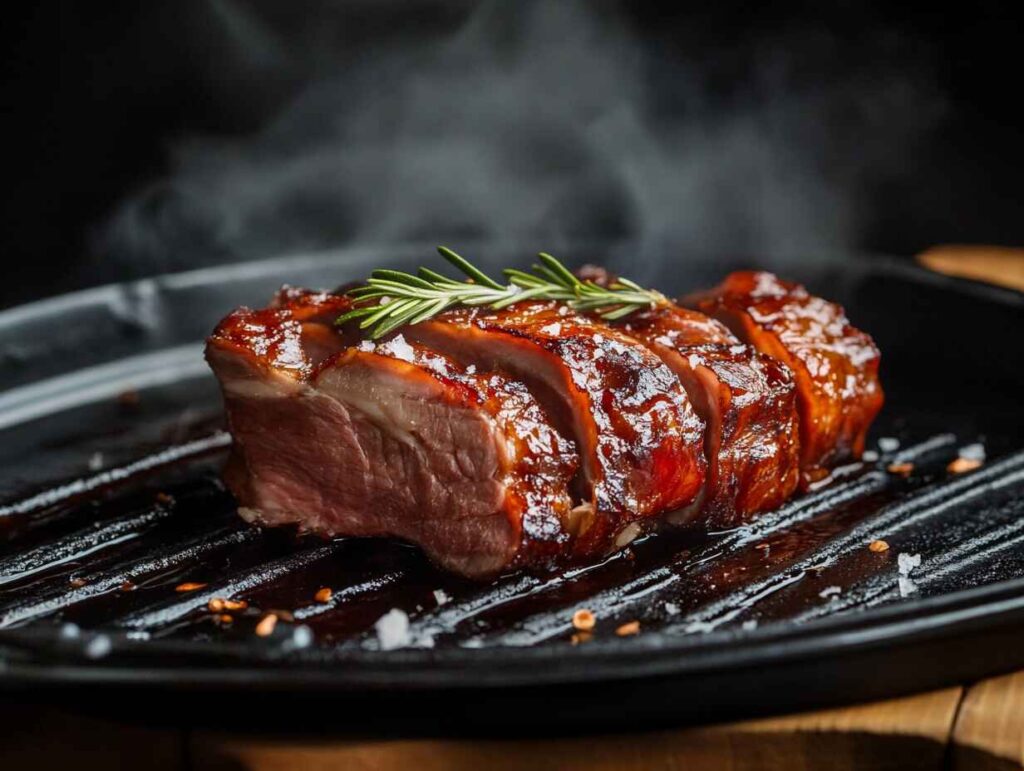
Understanding Smoked Meats Basics: Types and Techniques
Different Smoked Meats Types
Smokers come in different types. Electric smokers use electricity to heat the chamber. Charcoal smokers use burning charcoal for heat and smoke. Gas smokers use propane or natural gas. Pellet smokers use wood pellets as fuel, which provide both heat and smoke. Each type offers a unique smoking experience.
Temperature Control for Smoked Meats
Keeping a steady temperature is very important. Too hot, and you’ll burn your food. Too cold, and it won’t cook properly. Different smokers have different ways to control temperature. Electric smokers usually have digital controls. Charcoal and gas smokers need more attention; you might adjust vents or gas flow to keep the temperature right. Pellet smokers often have automatic temperature controls.
Smoked Meats Management
Smoke adds flavor. Too much smoke can make food taste bitter. Too little, and you won’t get that smoky taste. You manage smoke by controlling the amount of fuel and airflow in your smoker. Using wood chips or chunks helps create flavorful smoke.
Consistent Heat: The Key to Success
Consistent heat is key to good smoked beef. Fluctuations in temperature can make your meat tough or unevenly cooked. Monitor the temperature regularly, and adjust your smoker as needed. A good meat thermometer is very helpful.
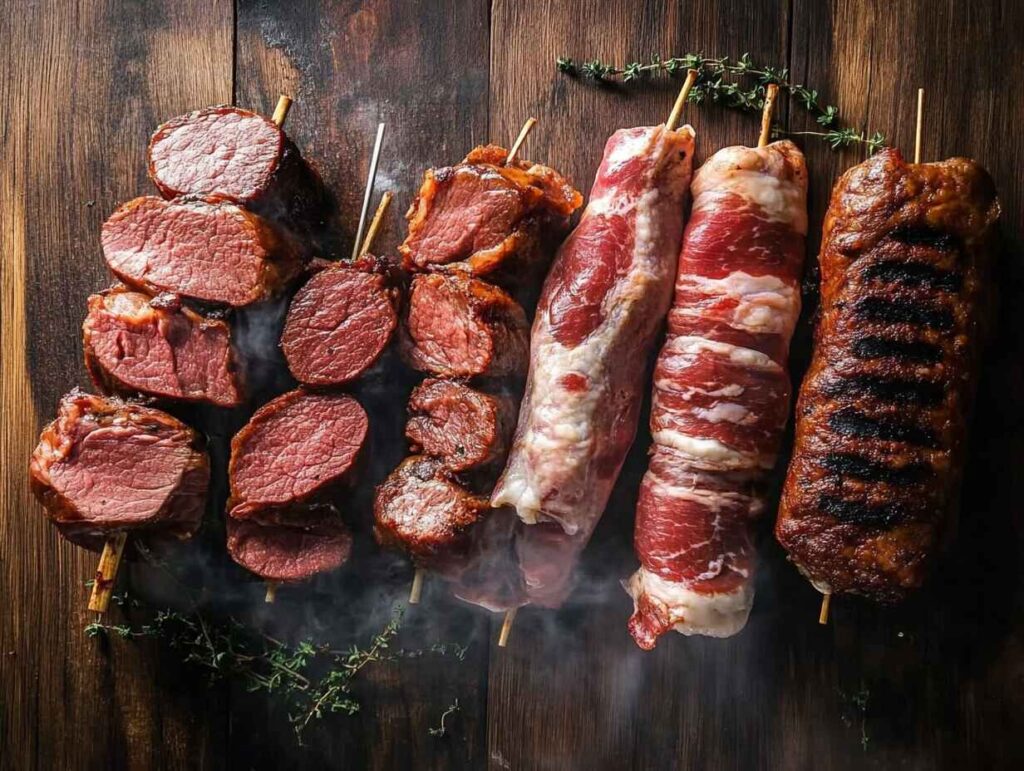
Selecting Your Meat: Smoked Meats Cuts and Considerations
Choosing the Right Cut
Picking the right cut of meat is important for great smoked meat. Different cuts cook differently. Brisket is a popular choice. It’s a tough cut, but smoking makes it tender and juicy. Beef ribs are also excellent. They have great flavor and become incredibly tender after smoking. A beef shoulder (also called a pork butt, but it’s beef!) is another good option. It’s a large cut, perfect for feeding many people. It’s also very flavorful and becomes fall-apart tender when smoked low and slow. Chicken is a much faster-cooking option; it’s great for beginners.
Meat Characteristics
Each cut has different qualities. Brisket has a lot of connective tissue, which breaks down during smoking. This is what makes it so tender. Ribs have more fat, which adds flavor and keeps them moist. Beef shoulder has a lot of fat and connective tissue, leading to incredibly tender results after a long smoking time. Chicken is leaner, so it cooks quickly, but you need to keep an eye on it to avoid drying it out.
How Meat Responds to Smoked Meats
The way the meat responds to the smoking process depends on the cut. Brisket needs low and slow cooking. Ribs need a bit more heat. Beef shoulder also benefits from low and slow cooking. Chicken cooks quickly at a higher temperature. A meat thermometer is your best friend here, regardless of the cut you select. Always check the internal temperature to make sure it’s cooked through.
Essential Ingredients: Wood and Rubs
Choosing the Right Smoking Wood
Wood type greatly affects the taste of your smoked meat. Different woods give different flavors. Hickory has a strong, smoky taste. Mesquite is even stronger and a bit bolder. Applewood is milder and sweeter. Experiment to find your favorites!
Making Your Own Rubs
Creating your own spice rubs is easy and fun. You control the flavors! A basic rub might include salt, pepper, garlic powder, onion powder, and paprika. Get creative! Add brown sugar for sweetness, or chili powder for heat.
Rub Recipe Example
Here’s a simple recipe to get you started:
| Ingredients | Quantity | Note |
|---|---|---|
| Brown Sugar | 2 tablespoons | Adds sweetness |
| Paprika | 1 tablespoon | Adds color and mild flavor |
| Garlic Powder | 1 tablespoon | Adds savory flavor |
| Onion Powder | 1 tablespoon | Adds savory flavor |
| Salt | 1 tablespoon | Enhances flavors |
| Black Pepper | 1 teaspoon | Adds a little kick |
Remember to adjust the amounts to your liking. Try adding other spices like cumin, cayenne pepper, or oregano. Experiment and have fun!
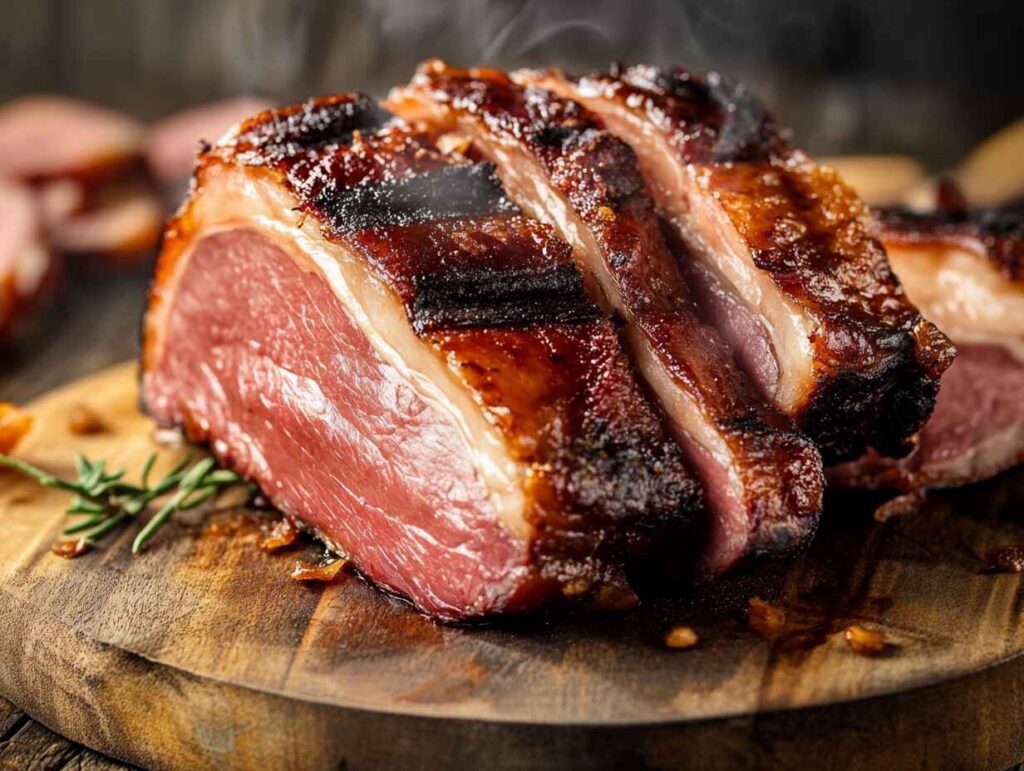
Preparing the Smoked Meats: Trimming and Injecting
Trimming Excess Fat: Smoked Meats
Before smoking, trim away any excess fat. Too much fat can make your meat greasy. Leave a little fat for flavor and moisture, but remove large chunks. Use a sharp knife.
Injecting Flavor: Smoked Meats
Injecting your meat adds extra flavor and moisture. Use a marinade injector. Popular marinade ingredients include vinager, Worcestershire sauce, and your favorite spices. Inject the marinade deep into the meat. This helps the flavors penetrate.
Making a Simple Marinade: Smoked Meats
A simple marinade uses equal parts vinager, soy sauce, and brown sugar. Add your favorite spices for extra flavor. Let the meat sit in the marinade for at least 2 hours, or overnight for best results. This allows the flavors to fully develop. For tougher cuts of beef, marinating is especially beneficial. It helps tenderize the meat while adding flavor.
Other Preparation Tips: Smoked Meats
Pat the meat dry before smoking. This helps create a good crust. Season the meat generously with your spice rub. Make sure to cover all sides. Applying a rub creates a flavorful crust. Now your meat is ready for the smoker!
The Smoking Process: Step-by-Step Instructions
Setting Up Your Smoked Meats
First, prepare your smoker. If it’s charcoal, arrange the coals. For gas or pellet smokers, turn them on and set the temperature. Make sure your smoker is clean. Then, place your meat on the grates.
Maintaining Temperature Smoked Meats
Use a meat thermometer to check the temperature inside the smoker. Keep a steady temperature. Adjust the vents or controls as needed. Different meats need different temperatures; check your recipe.
Monitoring Smoked Meats Temperature
Check the meat’s internal temperature regularly using a meat thermometer. This is the best way to know when it’s done. The temperature will depend on the meat. A beef brisket needs a lower temperature for longer than chicken.
Adding Wood Chips: Smoked Meats
Depending on your smoker, you might add wood chips or chunks to create smoke. This adds flavor. Don’t add too much at once.
Wrapping (Optional): Smoked Meats
Some people wrap their meat in butcher paper or foil during the smoking process. This helps keep it moist. It also speeds up the cooking time. Check your recipe to see if wrapping is recommended.
Finishing the Smoking Process for Smoked Meats
Once your meat reaches the correct internal temperature, it’s done! Remove it from the smoker. Let it rest for at least 15-30 minutes before slicing. This allows the juices to redistribute, making it more tender.
Checking for Doneness: Temperature and Texture
Using a Smoked Meats Thermometer
A meat thermometer is your best tool. It accurately measures the internal temperature of your meat. Different meats need different temperatures. Check the temperature frequently. Don’t rely on looks alone!
Safe Internal Temperatures
Here are some safe internal temperatures:
- Beef: 145°F (63°C)
- Beef Ribs: 190-205°F (88-96°C)
- Beef Shoulder: 190-205°F (88-96°C)
- Chicken: 165°F (74°C)
Let the meat rest for at least 15 minutes after cooking. This allows the juices to redistribute, making it more tender.
Checking for Tenderness
Besides temperature, check the texture. Tender meat should be easy to pierce with a fork. Brisket and beef shoulder should be very tender; you may be able to shred it with a fork. Beef ribs should be easily pulled apart. Chicken should be fully cooked and juicy. If it’s tough, it needs more cooking time.
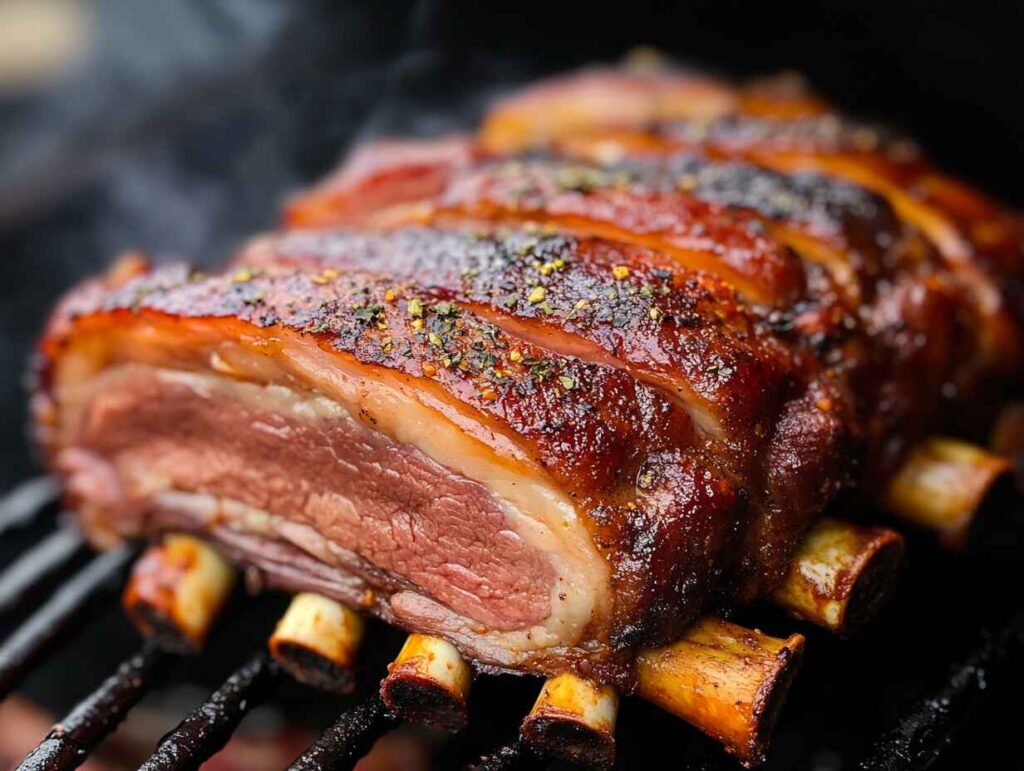
Resting and Slicing: Enhancing Flavor and Texture
Why Resting Matters
After you smoke your meat, letting it rest is super important. This resting time lets the juices spread back throughout the meat. This makes it much more tender and juicy. Rest your meat for at least 15 to 30 minutes, covered loosely with foil.
Slicing Techniques for Different Cuts
How you slice your meat also matters. For brisket, slice it against the grain. This means slicing across the direction the muscle fibers run. This makes the brisket much easier to chew. For beef ribs, you can cut them between the bones. Beef shoulder, once it’s very tender, can be pulled apart or chopped. Chicken is usually sliced or cut into pieces. Always use a sharp knife for the cleanest cuts.
Troubleshooting Common Issues
Uneven Cooking
Uneven cooking happens when parts of your meat cook faster than others. This often means your smoker’s temperature isn’t consistent. Use a good meat thermometer to check the temperature in different spots inside your smoker. Adjust vents or controls to keep the temperature even. Also, make sure your meat is arranged properly on the grates, allowing for even airflow around each piece.
Stalling
Sometimes, the meat’s temperature stops rising. This is called a stall. It usually happens when the meat’s surface is drying out. Wrapping your meat in butcher paper or foil can help prevent this. Wrapping traps moisture, keeping the meat moist and allowing the temperature to continue rising.
Dry Meat
Dry meat is a common problem. It happens if the meat cooks for too long at too high a temperature or if it loses too much moisture. Use a meat thermometer to ensure your meat reaches the right temperature, and don’t overcook it. Injecting a marinade adds moisture and flavor before you smoke the meat. Wrapping the meat during smoking also helps keep it juicy. Leaving the meat to rest after cooking also helps.
Frequently Asked Questions: Smoked Meats
What kind of smoker is best for beginners?
Electric smokers are often recommended for beginners because they’re easier to control temperature. They usually have digital controls, making it simpler to maintain a consistent heat.
How do I keep my smoked meat from drying out?
Use a meat thermometer to ensure you don’t overcook the meat. Injecting a marinade before smoking adds moisture and flavor. Wrapping the meat in butcher paper or foil during smoking also helps retain juices. Finally, let the meat rest after cooking to allow the juices to redistribute.
What woods are good for smoking beef?
Hickory gives a strong smoky flavor, while mesquite is even stronger. Applewood offers a milder, sweeter taste. Experiment to find your preference!
What temperature should I smoke my beef at?
The ideal temperature depends on the cut of beef. A beef brisket requires a lower temperature for a longer time than beef ribs or chicken. Always use a meat thermometer to monitor the internal temperature to ensure your beef reaches the safe temperature range.
How long does it take to smoke beef?
Smoking times vary greatly depending on the cut of beef and the desired level of doneness. Beef brisket can take many hours, while chicken cooks much faster. Always consult a recipe and use a meat thermometer to ensure it’s cooked thoroughly.
Mastering the Art of Smoked Meats
Your Smoking Journey
This guide gave you the basics of smoking meat. You learned about different smokers, how to control temperature and smoke, and how to choose the right meat cuts. We covered essential ingredients like wood and rubs, and walked you through preparing and smoking your meat. You also learned how to check for doneness and let your creation rest.
Practice Makes Perfect
Remember, smoking meat is a skill that improves with practice. Don’t be afraid to experiment with different woods, rubs, and cooking times. Each time you smoke, you’ll learn something new. Pay close attention to temperature and use a meat thermometer.
Enjoy Your Delicious Results!
Soon, you’ll be creating mouthwatering smoked meats that will impress your friends and family. This guide will help you master the art of smoking meats. Remember, patience, practice, and attention to detail are key to achieving delicious results!
Great choices! Here’s how you could present them as related articles on your website:
Related Articles
✔️ Smoked Sausage 101: Best Ways To Cook, Store, And Serve – Learn the secrets to perfectly smoking, storing, and serving sausages for maximum flavor and tenderness.
✔️ Are Turkey Drumsticks Really Dark Meat? The Shocking Truth! – Uncover the truth about turkey drumsticks and whether they’re truly considered dark meat.
✔️ Benihana Chicken Fried Rice: 15 Common Mistakes and How to Easily Fix Them – Master the art of making chicken fried rice with expert tips to avoid common mistakes and perfect your dish every time.
Print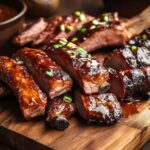
Smoked Meats: Unlock the Secret to Succulent, Mouthwatering BBQ!
- Total Time: Varies (4-17 hours including resting)
- Yield: 6–8 servings 1x
- Diet: Gluten Free
Description
Smoked meats are packed with rich, deep flavors achieved through slow cooking with wood smoke. Whether it’s brisket, ribs, pork shoulder, or chicken, smoking enhances the natural juices while adding a delicious smoky essence. Perfect for BBQ lovers, this method creates tender, flavorful meat with a satisfying crust.
Ingredients
(Adjust based on the type of meat)
- 5 lbs of meat (brisket, ribs, pork shoulder, chicken, or turkey)
- 2 tbsp kosher salt
- 2 tbsp black pepper
- 1 tbsp garlic powder
- 1 tbsp onion powder
- 1 tbsp smoked paprika
- 1 tsp cayenne pepper (optional for heat)
- ½ cup brown sugar (for pork or ribs)
- ¼ cup yellow mustard (as a binder, optional)
- Wood chips or chunks (hickory, applewood, mesquite, or cherry)
Instructions
Prepare the Meat
- Trim excess fat if necessary.
- Rub mustard on the meat (if using) to help the seasoning stick.
- Generously apply the dry rub all over the meat. Let it rest at room temperature for 30 minutes.
Prepare the Smoker
- Preheat the smoker to 225°F (107°C).
- Add your preferred wood chips/chunks for desired smoke flavor.
Smoking Process
- Place the meat in the smoker, fat-side up if applicable.
- Maintain a consistent temperature of 225°F (107°C).
- Smoke until the internal temperature reaches:
- Brisket: 195–205°F (90–96°C) (12-16 hours)
- Ribs: 190–203°F (88–95°C) (5-6 hours)
- Pork Shoulder: 195–205°F (90–96°C) (8-10 hours)
- Chicken: 165°F (74°C) (3-4 hours)
Wrapping (Optional for Juiciness)
- Wrap the meat in butcher paper or foil once it hits the stall (around 160°F/71°C) for brisket and pork shoulder.
Resting the Meat
- Let the meat rest for at least 30-60 minutes before slicing to retain juices.
Serving
- Slice against the grain for brisket.
- Serve ribs and pork shoulder with BBQ sauce if desired.
Notes
- Use a meat thermometer to ensure accuracy.
- Different wood types give different flavors: hickory is strong, applewood is mild and sweet.
- For extra moisture, place a water pan in the smoker.
- Experiment with different rubs and marinades for unique flavors.
- Prep Time: 30 minutes
- Cook Time: Varies (4-16 hours depending on meat)
- Category: Dinner, BBQ
- Method: Smoking
- Cuisine: American, BBQ
Nutrition
- Serving Size: 6 oz
- Calories: 350
- Sugar: 2g
- Sodium: 600mg
- Fat: 22g
- Saturated Fat: 8g
- Unsaturated Fat: 12g
- Trans Fat: 0g
- Carbohydrates: 3g
- Fiber: 0g
- Protein: 35g
- Cholesterol: 100mg

I am not a meat eater but when my husband cooked this dish by following the listed ingredients I tried a little piece from my daughter plate and I couldn’t believe how good it was so I asked my husband to make me a plate and I enjoyed a lovely dinner with my small family, it was absolutely Amazing.
I appreciate your kind words! Hope the recipe brings some tasty moments to your kitchen!